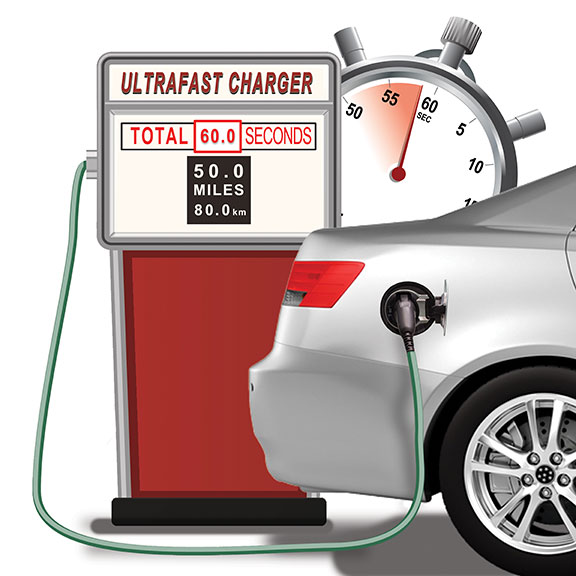Contributed commentary by Robert A. Rango, President and CEO, Enevate Corp.
August 1, 2017 | Electric vehicles are the most revolutionary development in the auto industry since the internal combustion engine. Every day they get more advanced and more popular. Electric cars and plug-in hybrids are projected to account for an average of 8 percent of all cars sold in the United States by 2020. While that shows tremendous growth in electric vehicles (EVs), you dont have to be a statistician to notice that this is still a fairly small percentage. EVs are becoming more affordable (although they may not be as affordable as cars with internal combustion engines until the 2020s). Plus, there are great government incentives that make it easy, and at least comparable in price to standard auto sales, for people to switch to EVs. So whats holding the market back?
In a word: batteries.
 Although batteries arent the most glamorous part of an electric vehicle, they are the most important. Theyre also the biggest stumbling block today to growing the EV market, thanks to the range anxiety they produce. Drivers with electric cars generally have to plug in overnight to maintain their 100-plus-mile range. Considering that most Americans drive just about 30 miles a day, thats a full eight-hour charge at home overnight every week, as opposed to taking five minutes to refuel roughly every 10 days. If you notice your battery is low at work or while on a road trip, refueling for so many critical hours can be a scary proposition. And if you dont have a 240-volt outlet with an accompanying parking space for lengthy charging at home, life with an EV can be pretty inconvenient. While the numbers are getting better, thats still the kind of math that keeps people tethered to their gas-powered cars.
Although batteries arent the most glamorous part of an electric vehicle, they are the most important. Theyre also the biggest stumbling block today to growing the EV market, thanks to the range anxiety they produce. Drivers with electric cars generally have to plug in overnight to maintain their 100-plus-mile range. Considering that most Americans drive just about 30 miles a day, thats a full eight-hour charge at home overnight every week, as opposed to taking five minutes to refuel roughly every 10 days. If you notice your battery is low at work or while on a road trip, refueling for so many critical hours can be a scary proposition. And if you dont have a 240-volt outlet with an accompanying parking space for lengthy charging at home, life with an EV can be pretty inconvenient. While the numbers are getting better, thats still the kind of math that keeps people tethered to their gas-powered cars.
But a big change is on the horizon: a new generation of batteries that can get a significant charge in five minutes. Five minutes is the same amount of time it takes for a gas refill. Five minutes is what it takes to run into a convenience store for a washroom break and a coffee refill.
What put us on the verge of this ultrafast-charge revolution? Silicon-dominant lithium ion (Li-ion) batteries, like the ones that use the technology from Enevate. The next generation of EVs that use these new batteries could hit the market as soon as three years from now. These batteries use silicon in place of graphite in the battery anodes and are a huge step up from the traditional Li-ion batteries currently on the market. They are lighter and safer and can operate even in the coldest temperatures.

Most significantly, though, silicon soaks up approximately 5 to 10 times more energy than graphite, and does so much faster. With a silicon-dominant Li-ion battery, in just 15 minutes youll get a full charge. In five minutes, youll get a significant charge that will last for days. In fact, in 60 seconds, you can charge a large battery enough to go up to 50 miles.
That is a game changer.
Here are five ways that EVs stocked with next-generation ultrafast-charging batteries will soon change everything:
1. EVs will Get 200-Plus Miles on a Five-Minute Charge: Right now, the fastest an EV can gather a significant charge is 45 minutes. Thats due to the Tesla Supercharger, which can get a Model S with an 85 kWh battery to 80 percent charge in that time. Thats not terrible if youre lucky enough to find a supercharging station and dont mind waiting for an opening. (In Los Angeles, ground zero for Teslas, there are only four such stations.) But when you think about it, 45 minutes is still a lot longer than most of us want to spend at a gas station or lunch counter. Just about every long-distance driver is happy to stop every few hours for a five-minute bathroom break, though. Ultrafast-charging silicon-dominant EV batteries are poised to make this the new norm in EV charging.
2. EVs will go Farther: Range anxiety, even if overblown, is a serious problem with EVs. Even when an EV panel or battery fuel gauge says it has 99 miles to go, many people have trouble trusting any number in the double digits because variables like hills or drops in temperature can quickly suck up those extra miles. But next-generation ultrafast-charging batteries can extend the range in both of these cases. For one thing, silicon-dominant batteries have higher energy density, which provides more battery capacity and range for the same battery size. Also, silicon-dominant ultrafast-charging batteries are minimally affected by cold climates. When an electric or hybrid vehicle goes downhill or triggers regenerative braking, an ultrafast-charging battery can absorb the energy very quickly at high currents, ultimately giving back 10 percent to 15 percent of expended energy. With a silicon-dominant battery in cold climates, electric vehicles can provide up to 20 percent longer range.
3. More Affordable EVs: A smaller battery that can be ultrafast-charged along the way would be less expensive both in EV purchase price and trip value. Most of the cost of an electric vehicle is in the battery: the bigger the battery, the higher the price. If you could create a smaller and lighter battery pack that charges ultrafast and has a higher energy density, there would be no need for a huge battery. Its a shift in mindset; a smaller battery pack may need to be recharged more often, but only in short ultrafast charges rather than overnight.
EVs installed with an ultrafast-charging battery would also be easier on the wallet when it comes to fueling. Right now we are accustomed to paying about $50 to gas up a car for 300 miles. For a far less expensive charge, you can go the same range with a next-generation EV. Consider Tesla again: Even now, the company says that supercharging costs just $15 in electricity to drive from Los Angeles to the Bay Area, a trip that is approximately 380 miles.
4. A Dramatic Change in EV Charging Infrastructure: With a nearly full charge in five minutes that gives you a significant amount of range, ultrafast-charging EVs will be able to race through charging hubs just like they were typical gas stations. Ultrafast charging is expected to increase the number of EVs served in a station by five to eight times, so we might actually see a reduction in the number of dedicated public charging stations and a rise in quick-charge spots. Any parking lot can become a charging station, because its a lot easier to distribute electricity than gasoline (the electric grids are already in place). Right now, though, commercial building owners are reluctant to add too many charging stations at parking spots near their properties because cars have to stay in them for such a long time to charge. If cars could charge up in just a few minutes, workplaces and public destinations might be more willing to set up stations, not only for their employees and consumers but also for delivery trucks, ride-share services and any other commercial vehicle that needs a quick boost.
More ultrafast chargers mean more people can charge their cars in more places, which will help stimulate the market for electric vehicles. It will also further open this market to the 58 percent of Americans who dont have access to an EV plug, whether its in an overnight charging location or at home in their garage or carport. Short charging times, longer range, more affordable EVs, and more prevalent and efficient charging stations will lead to more EV sales.
5. EV Fleets Just Might Spike in Popularity: This all just might lead to significant investments in fleets of autonomous EVs, which are now hindered by their need to charge for hours. Currently, EV fleets have to be sizable because so many vehicles, with their large batteries, have to sit at chargers for significant periods of time. If fleets had EVs with ultrafast-charging next-generation batteries and chargers, these vehicles would need less time at the chargers. A greater number of EVs could be rotated through the chargers on a quicker cycle, allowing for fewer fleet vehicles necessary to surpass the older generations productivity. Overall cost for a smaller yet more industrious fleet of EVs might suddenly become more appealing.
Ultrafast-charging EVs would greatly reduce range anxiety for long-distance trips and long commutes, and make them attractive to just about everybody. In other words, more people will buy the next generation of EVs if they know they can accomplish everything listed above.
It seems reasonable that mass adoption will only take place when these vehicles are considered to be the first choice in a household, said Edward Tuttle, managing principal at Analysis Group, a private economics consultancy.
The mix of next-generation ultrafast-charging EV batteries and more ultrafast-charging options, combined with longer-range and more affordable EVs, has enormous potential for the US. We could finally be on the brink of the kind of EV revolution that was once the stuff of science fiction. From now on, carmakers will be thinking in terms of more efficient batteries instead of bigger batteries. And thats going to make all the difference.
 Bob Rango has more than 33 years of technology and leadership experience. Before joining Enevate, he was executive vice president and general manager of Broadcom’s multibillion-dollar mobile and wireless group, where he led a team that captured No.1 global market share positions in Wi-Fi, Bluetooth and GPS chips. Prior to that, Bob held executive roles at Lucent Microelectronics and Agere Systems. Early in his career he was an engineer at AT&T Bell Labs. Bob is a board member at multiple public companies and holds a master’s degree in electrical engineering from Cornell University and a bachelors degree in electrical engineering from State University of New York at Stony Brook.
Bob Rango has more than 33 years of technology and leadership experience. Before joining Enevate, he was executive vice president and general manager of Broadcom’s multibillion-dollar mobile and wireless group, where he led a team that captured No.1 global market share positions in Wi-Fi, Bluetooth and GPS chips. Prior to that, Bob held executive roles at Lucent Microelectronics and Agere Systems. Early in his career he was an engineer at AT&T Bell Labs. Bob is a board member at multiple public companies and holds a master’s degree in electrical engineering from Cornell University and a bachelors degree in electrical engineering from State University of New York at Stony Brook.







